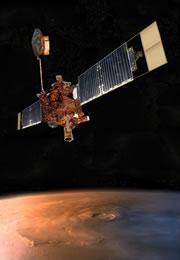 Mars Global Surveyor provided the first truly reliable global topographic map of Mars.NASA/JPL
Mars Global Surveyor provided the first truly reliable global topographic map of Mars.NASA/JPLNASA scientists say they may have to bid farewell to a dear old friend — Mars Global Surveyor (MGS). NASA lost contact with the craft on 2 November as it was coming out from behind Mars, just five days before the tenth anniversary of its launch. The last they heard from it was a possible faint signal on 5 November.
Tom Thorpe, project manager for the Surveyor, speculates that the motors rotating the craft's solar panels got stuck. Without the panels in the right orientation, the orbiter can't get power from the Sun.
Despite bombarding the craft with more than 800 command files since 5 November in an attempt to get it to say something, the orbiter remains stubbornly silent.
But as MGS drifts off to the planetary orbiter graveyard, a new craft — Mars Reconnaissance Orbiter (MRO) — has started gathering data from Mars. It arrived at the red planet in March and spent its first week taking low-orbit observations this October, producing stunning pictures of the planet — including a snap in which the Mars rover Opportunity can be seen perched on the edge of a crater.
The Orbiter was called upon to try and spot its predecessor, so that it might help to diagnose the problem; it took some large pictures with its star scanner camera of the part of the sky where mission managers thought the ailing Surveyor should be.
It will be some time before these data are fully analysed, but MRO deputy project manager Jim Erickson doesn't sound optimistic about even having seen the craft, let alone getting close enough to spot the problem. "We're not sure we've seen anything in any of the images that could be a sighting," he says.
Mapped for landing
MGS's most notable scientific achievements were to provide the first truly reliable global topographic map of the planet and to reveal swathes of the surface in far greater detail than ever before. It also provided the first analysis of Mars's ancient magnetic fields. Perhaps its most dramatic discovery was of fresh gullies in the walls of some craters and along some other slopes that seemd to have been formed by recent fluid flow.
More recently it has been helping MRO to scout a good landing spot for the next generation of Mars probes — Phoenix, due to arrive at Mars in 2008, and Mars Science Lab, which will touch down in 2010. MRO will take over this job.
ADVERTISEMENT
Fuk Li, Mars exploration programme manager at NASA's Jet Propulsion Laboratory in Pasadena, California, says options for contacting MGS are still being considered and he refuses to give up all hope. But as time passes the uncertainty in the Surveyor's orbit becomes greater, making it harder to find. "The prospect of recovering MGS is not looking good at all," says Li.
Mars Reconnaissance Orbiter's mission runs until 2010, but is expected to last much longer than that. Mars is currently circled by two other operating craft, NASA's Mars Odyssey and Europe's Mars Express. The overlap in survival between MGS and these missions marks the first time that a craft orbiting a planet (other than Earth) has passed its baton on to another.
Visit our marsglobal_surveyor.html">newsblog to read and post comments about this story.
